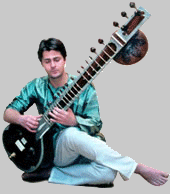Niklas Holmberg- official website | ||
About Indian music
Indian music has ancient roots and one of the earliest records of music is found in the Sama Veda that dates back thousands of years. Two distinctively different musical systems have developed in India into what we today refer to as Hindustani (North Indian) and Carnatic (South Indian) music. In Carnatic Music. RagasEach Raga has its origin in one of the basic scales and each Raga and basic scale has a number of fixed notes that are supposed to be played in a certain order depending on if the vocalist/instrumentalist makes an ascending (arohana) movement or a descending (avarohana) movement. Each raga and scale has its roots in a rasa (mood) and the Raga is set to produce one of these moods or rasas. This is one of the major differences between western and Indian music. Indian Raga music concentrates on one mood whereas western music mixes moods freely. The 10 basic scales of Hindustani music that also are popular Ragas: 1. Bilawal Talas (Rhythm)
The instrumentalist/vocalist is most often accompanied by the tabla (Hindustani music) or the Mridangam (Carnatic music) as the keeper of Rhythm and the rhythmic cycles are known as Talas or Talams. The most popular tala in Hindustani music is Teental of 16 beats divided into 4+4+4+4 and another popular tala is Jhaptal of 10 beats divided into 2+3+2+3. Within Hindustani and Carnatic music numerous talas have been developed and according to some expert there should be more than 1000 different talas. The talas are in themselves fixed compositions and the stressing of Sum by the percussionist (the first beat in any tala) is essential for the instrumentalist/vocalist in order to keep track of where in the composition they are.
|
All contents on this website such as music,video,photo and text
Copyright ©2010 Niklas Holmberg. All Rights Reserved.
Black & White Photo: Petteri Koste

